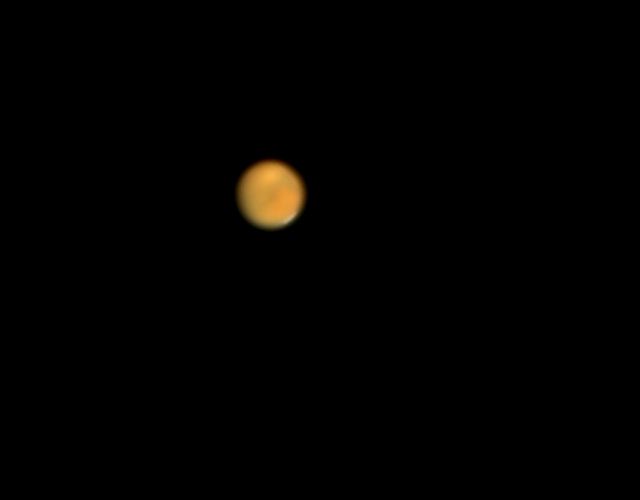
Mars

This photo of Mars was taken on the 24th of November 2005. It was a bitterly cold night with a northerly wind. The sky was crystalline in a way which is only seen on frosty nights in winter in England. Mars is 43,153, 000 miles from earth at this time - and is 17 days after opposition. It will not be closer than this until 2018.
For this photo, in order to get maximum size, I removed the focal reducer which I use for deep sky object photography and used the telescope's native f10 focal ratio. This is only the second time I have used Meade's LPI (Lunar Planetary Imager) which shipped with my LX90. The software interface in Autostar Suite for LPI is more basic than for the DSI. The auto-adjustment for exposure speed, and contrast settings tended towards over-exposure so that no features could be seen on the planet and the colour was bleached white. By turning the exposure time down manually to about 0.008 seconds, I was able to see albedo features and the southern polar ice cap even on the screen as the LPI turned over one image after another. This particular image is a stack of 51x0.008, 63x0.008, 70x0.008 seconds, and 64x0.008 with a yellow filter (thanks again, Dick!) making a total exposure time of 1.984 seconds - an almost 2 second exposure.
Processing was brief and uninvolved. Using Photoshop, I adjusted the contrast with the levels setting in the RGB (luminosity) channel. There was minor enhancement of the colour balance towards the red using Image/Adjustments/Colour balance function and finally a light unsharp mask was applied.
Problems - the wind caused substantial vibration against the telescope barrel even though the Meade tripod and mount system is extremely sturdy, steady and solid. Although software tracking in the LPI software interface manages to steady the image-stacks, I feel the quality of the edge would have been better if it had been a still night. Likewise, atmospheric effects caused shimmering of the image like in a mirage at the high magnifications of the LPI or through a 9mm eyepiece.
HOME PICTURES: Deep Sky PICTURES: Solar system PICTURES: Wide field